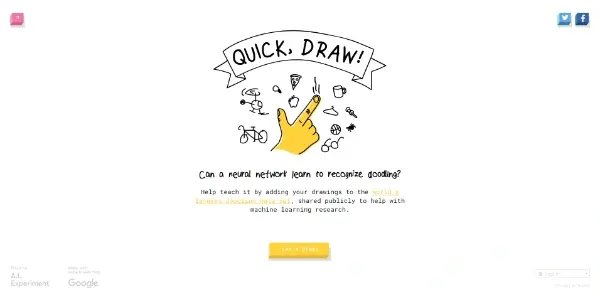Quick Draw by Google

Draw and an AI will try to guess what it is. The more you play, the more it learns new concepts. A playful example of how machine learning works
Quick, Draw! by Google: A Deep Dive into AI-Powered Sketch Recognition
Quick, Draw! is a free online game developed by Google that uses machine learning to guess what users are drawing. It serves as a playful yet insightful demonstration of how machine learning algorithms learn and improve over time. By engaging users in a simple drawing task, it effectively showcases the power and potential of artificial intelligence in image recognition.
What Quick, Draw! Does
Quick, Draw! challenges users to draw a series of objects within a short time limit (typically 20 seconds). As the user sketches, the AI attempts to identify the drawing in real-time. The algorithm analyzes the strokes and patterns in the drawing to make its prediction. The more people use the game, the more data the AI receives, allowing it to learn and improve its accuracy in recognizing a wider variety of drawings, even those that are stylistically diverse or poorly executed.
Main Features and Benefits
- Intuitive Interface: The game is incredibly user-friendly, requiring no prior knowledge or experience with AI or drawing programs. The simple interface makes it accessible to all ages and skill levels.
- Interactive Learning: Users learn indirectly about the process of machine learning by seeing how the AI improves its accuracy over time. It's a practical and engaging way to understand the core concepts of AI without needing technical expertise.
- Gamified Learning: The timed aspect and the challenge of getting the AI to correctly guess the drawing makes the process fun and engaging, encouraging continued use and learning.
- Data Contribution: By playing the game, users contribute to a massive dataset that helps train Google's AI models, improving the accuracy of image recognition across various Google products and services.
- Cross-Platform Accessibility: Quick, Draw! is accessible via web browsers on various devices, making it readily available to a wide audience.
Use Cases and Applications
While primarily a fun game, Quick, Draw! has several practical applications:
- Educational Tool: It can be used in classrooms to teach basic concepts of AI, machine learning, and image recognition in an engaging manner.
- Research and Development: The vast dataset generated by the game provides valuable data for researchers working on improving AI algorithms for image recognition and other related fields.
- Accessibility Applications: The underlying technology can be adapted for applications that aid individuals with disabilities, such as allowing users to communicate or interact with technology through drawing rather than typing.
Comparison to Similar Tools
Several other tools offer similar sketch recognition capabilities, but Quick, Draw!'s unique strength lies in its accessibility, gamified approach, and the educational value it provides. While other tools might focus on professional applications or require more technical expertise, Quick, Draw! successfully bridges the gap between sophisticated AI technology and the general public. Competitors might offer more advanced features or higher accuracy, but lack the playful, educational aspect that Quick, Draw! excels in.
Pricing Information
Quick, Draw! is completely free to use. There are no subscription fees, in-app purchases, or hidden costs.
In conclusion, Quick, Draw! is more than just a fun online game; it's a powerful demonstration of the capabilities of AI and a valuable educational tool. Its simplicity, accessibility, and engaging gameplay make it an exceptional resource for both entertainment and learning. The game's contribution to the advancement of machine learning further solidifies its importance in the world of artificial intelligence.